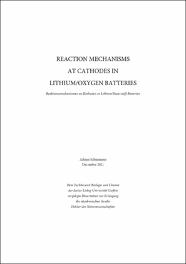| dc.contributor.advisor | Janek, Jürgen | |
| dc.contributor.advisor | Schröder, Daniel | |
| dc.contributor.author | Schürmann, Adrian | |
| dc.date.accessioned | 2022-05-04T12:34:56Z | |
| dc.date.available | 2022-05-04T12:34:56Z | |
| dc.date.issued | 2021-12 | |
| dc.identifier.uri | https://jlupub.ub.uni-giessen.de//handle/jlupub/873 | |
| dc.identifier.uri | http://dx.doi.org/10.22029/jlupub-764 | |
| dc.description.abstract | Aprotic lithium/oxygen (Li/O2) batteries are still seen as a highly promising technology for mobile energy storage, as they, in theory, exceed the theoretical energy density of state-of-the-art lithium-ion batteries (LIBs) by roughly an order of magnitude. However, Li/O2 batteries are plagued by a low lifetime and high charging overvoltages rooting in the poor electronic conductivity of the discharge product lithium peroxide (Li2O2) and manifold degradation reactions. This thesis examines two key aspects of Li/O2 batteries in detail: first, the solubility and diffusivity of oxygen within the electrolyte and second, the possible formation of singlet oxygen (1O2) from reactions involving superoxides and peroxides during cell cycling.
In detail, this thesis contains a systematic study to determine a consistent set of Henry’s law constants and diffusion coefficients of oxygen in different glymes and perfluorinated solvents. The study uses an experimental approach (time dependent pressure measurements) as well as simulations (molecular dynamic simulation) to determine the diffusion coefficients of oxygen. The difference between simulated and measured diffusion coefficients is sufficiently small, showing that both approaches can be used to determine these values. The established methods and protocols can be adapted to study emerging electrolytes for metal/O2 batteries with different polarity and varying magnitudes of Henry’s law constants and diffusion coefficients.
In recent years, 1O2 was identified as possible root cause of the manifold degradation reactions observed in Li/O2 batteries. While experimental indications were found, a complete picture including electron transfer theory was missing and thus the role of 1O2 is still controversially discussed. Therefore, literature on singlet oxygen with a focus on Li/O2 batteries is reviewed in this thesis, starting from the first detection of 1O2 in the 1960s. Experimental techniques for detecting and quantifying 1O2 such as trapping, quenching and luminescence as well as their potential pitfalls are evaluated and discussed. Moreover, for the first time Marcus(–Hush–Chidsey) theory as a model to describe and understand 1O2 in electrochemistry and especially Li/O2 batteries is introduced and critically discussed. Overall, the review reveals that the evidence to date is insufficient to assume 1O2 formation. The reaction mechanisms proposed for 1O2 formation in the literature must also be considered with caution.
The findings of this work provide a profound understanding of the transport and reaction mechanisms of oxygen and its reduced counterparts superoxide and peroxide in Li/O2 batteries. The concepts introduced in this thesis can be transferred to neighboring areas like fuel cells, water electrolysis and metal corrosion processes, thus advancing the understanding of oxygen reactivity in electrochemical systems. | de_DE |
| dc.description.sponsorship | Bundesministerium für Bildung und Forschung (BMBF); ROR-ID:04pz7b180 | de_DE |
| dc.language.iso | en | de_DE |
| dc.relation.haspart | https://doi.org/10.1149/2.0601813jes | de_DE |
| dc.relation.haspart | https://doi.org/10.1021/acs.chemrev.1c00139 | de_DE |
| dc.rights | In Copyright | * |
| dc.rights.uri | http://rightsstatements.org/page/InC/1.0/ | * |
| dc.subject | Singulett Sauerstoff | de_DE |
| dc.subject | Lithium/Sauerstoff Batterien | de_DE |
| dc.subject | Diffusion | de_DE |
| dc.subject | Absorption | de_DE |
| dc.subject | Löslichkeit von Gasen | de_DE |
| dc.subject | Marcus Theorie | de_DE |
| dc.subject | Elektrochemie | de_DE |
| dc.subject | Sauerstoff | de_DE |
| dc.subject.ddc | ddc:500 | de_DE |
| dc.subject.ddc | ddc:540 | de_DE |
| dc.title | Reaction Mechanisms at Cathodes in Lithium/Oxygen Batteries | de_DE |
| dc.title.alternative | Reaktionsmechanismen an Kathoden in Lithium/Sauerstoff-Batterien | de_DE |
| dc.type | doctoralThesis | de_DE |
| dcterms.dateAccepted | 2022-03-10 | |
| local.affiliation | FB 08 - Biologie und Chemie | de_DE |
| local.project | 03XP0047D - BenchBatt | de_DE |
| thesis.level | thesis.doctoral | de_DE |



